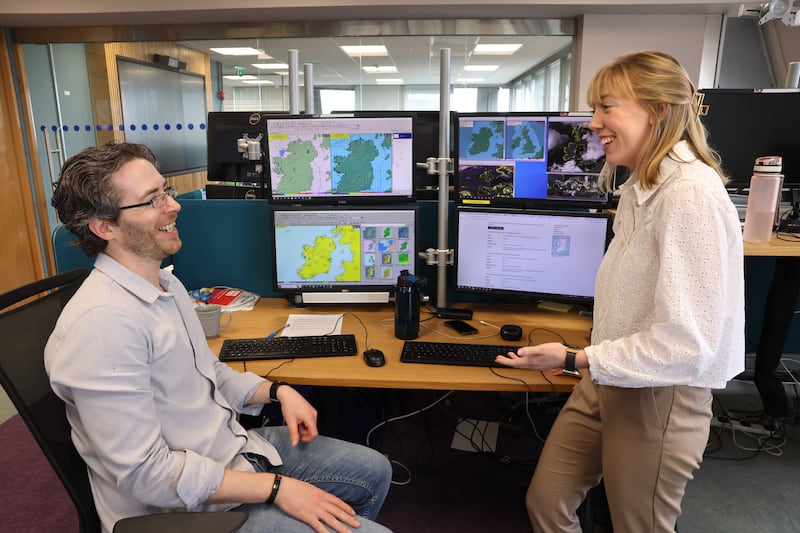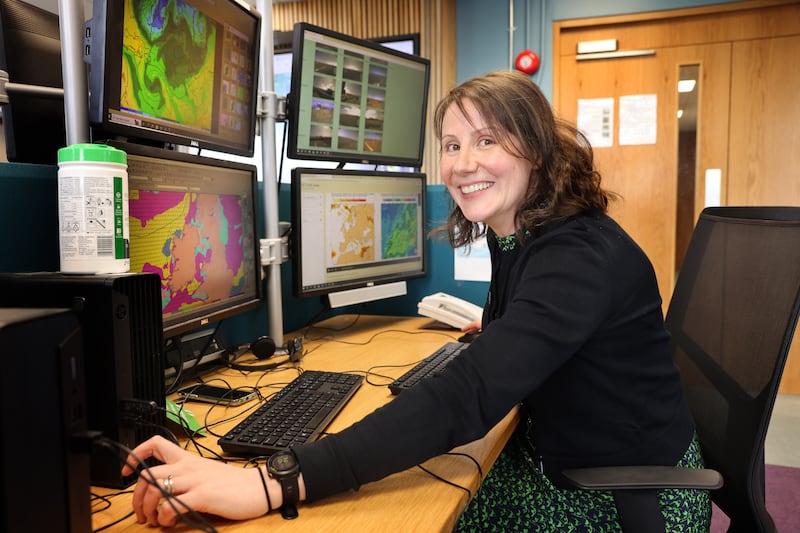It is as if the weather gods are mocking Met Éireann’s forecasters on Wednesday as a small but resolute blanket of grey settles over its Glasnevin headquarters just as it promises the nation another day of unbroken sunshine.
The forecaster’s head of operations, Séan Venn, is in the lobby wearing shorts and sandals, just another person caught out by the surprising cloud over the capital.
He is stoic and clearly accustomed to being let down by Ireland’s capricious weather.
Venn joined the forecasting service in 1996 and was immediately sent to Malin Head and given the job of collecting weather data to be sent to Dublin.
READ MORE
“It was all done manually then,” he says. “Almost as soon as I arrived and realised how remote the posting was, I rang here and asked to be transferred anywhere else.”

The answer was a hard no so he stayed where he was. He stayed for 14 years as it happened and quickly learned to love his remote posting. With automation and dramatic advances in technology, the role ceased to be in 2010 and Venn has been in his home city ever since.
He walks The Irish Times to the heart of the operation, a small nondescript office made up of a cluster of desks on which banks of computers rest.
[ Ireland weather forecast: UV levels high as temperatures set to hit 25 degreesOpens in new window ]
Andrew Doran-Sherlock, one of the two forecasters on duty, is looking at an array of computer screens deciphering what satellite images and maps of complex wind patterns are telling him.
He points to the tiny patch of cloud that has blocked out the sun across Dublin for most of the day.
“Our modelling didn’t do a great job predicting that,” he admits.
“Forecasting models have improved dramatically over the years but they are not always correct. That is why we, as forecasters, use observations and our knowledge of the dynamics of the atmosphere in conjunction with the forecasting models to produce and update our text forecasts.”**

He looks out the window of the pyramid-like building in the shadow of the Botanical Gardens for a sign there will be a break in the clouds, just like anyone else might. Some tiny flecks of blue on the horizon offer hope.
He says the job he has been doing for more than six years is “very much weather-dependent” before pausing.
“I hate to say that but it’s true. We have set tasks each day but a lot of what we do is shaped by the weather. It determines if we issue general warnings or alert utilities or State agencies to what is coming,” he says.
Do people ever blame him if the forecasts are wrong or if the weather is not what they’d like it to be?
“Sometimes,” he says.
“Oh yes,” comes a more forceful response from across a small partition where fellow forecaster Liz Walsh is watching a similar bank of computer screens and deciding whether or not to issue a small-craft alert for the water off the coast of Galway.
[ Should we worry about our children’s lives in the climate crisis?Opens in new window ]
[ Climate change could place even further stress on overstretched land useOpens in new window ]
She joined Met Éireann in 2006 before leaving to explore the world. She worked as a forecaster in New Zealand and the UK and returned to Dublin in 2016.
“My aunts and uncles do give out if we don’t get things right,” she says.
She does her best.
“The big challenge is the decision-making process and making a call as to whether or not to issue a warning or in what circumstances should we issue a warning,” she says.
She points to 12 maps on a large monitor, one of which is telling her a Force 6 is heading towards Galway Bay. The other 11 screens are not so convinced.
“The screen forecasting the wind is known as the unperturbed model,” she explains.
In the simplest of terms, it is the control forecast while the 11 other maps are possible outcomes based on what the maths contained in the original image is saying.
“If I was in Galway, I might go out on a kayak because it is so beautiful and I wouldn’t have a clue this weather was on the way. That is why a small-craft warning is important,” she says.
Like all the forecasters, Walsh is acutely aware of the challenges and threats posed by climate change, something increasingly shaping her role.
“We will see things we have never seen before. And while the signals for Ireland are not that strong, there will be extremes,” says Walsh.

She enjoys working in an Irish context because of the challenges forecasting in a marine-based climate pose. “It is definitely more interesting because things can change so quickly with so many variables,” she says.
Is that why forecasters hedge their bets with the catch-all “sunny spells and scattered showers” line?
“You would be surprised how often that is exactly right,” she says with a smile.
Alan Hally is the forecasting services manager and he introduces himself by saying he is responsible for the third-party weather services, the provision of weather data to government bodies, State agencies and large multinational corporations.
It doesn’t sound overly interesting but it quickly emerges that his role is substantially more than that. He also looks after the forecaster’s super computers, the machines generating the data needed to make accurate predictions.
At present, that data is pulled from computers with enormous processing power based in the Netherlands and the UK but a new supercomputer based in Iceland that can carry out 4,000 trillion calculations every second will soon come on stream. Such processing speed is hard to comprehend unless you consider that it would take a human who can carry out one calculation every second more than 100 million years to achieve what the machine can do in the time it takes to say the word Lisdoonvarna.
“What all that means is we get much higher-resolution pictures and much more accurate forecasting in more precise locations,” Hally says.
Walsh, meanwhile, is looking ahead to this weekend and beyond. The good news is she is as optimistic as she can be.
“What we have now is a blocking high and we have high pressure stacked on high pressure so I think we can say with a degree of certainty that the weather will be nice for the next five to seven days and possibly stretching out for longer,” she says.
“The length of time we can forecast is usually up to seven days but it does vary and now we have high pressure but we also have high certainty.”
*This article was amended on Thursday, June 8th, 2023. An earlier version of the article incorrectly stated that Séan Venn worked in Mizen Head rather than Malin Head and that he is a Dubliner when he is in fact from Bantry in Co Cork.
**This article was amended on Tuesday, June 13th, 2023 to include a quote that more accurately reflected the point Andrew Doran-Sherlock made about forecasting, which a previous version of the quote failed to fully capture.

















